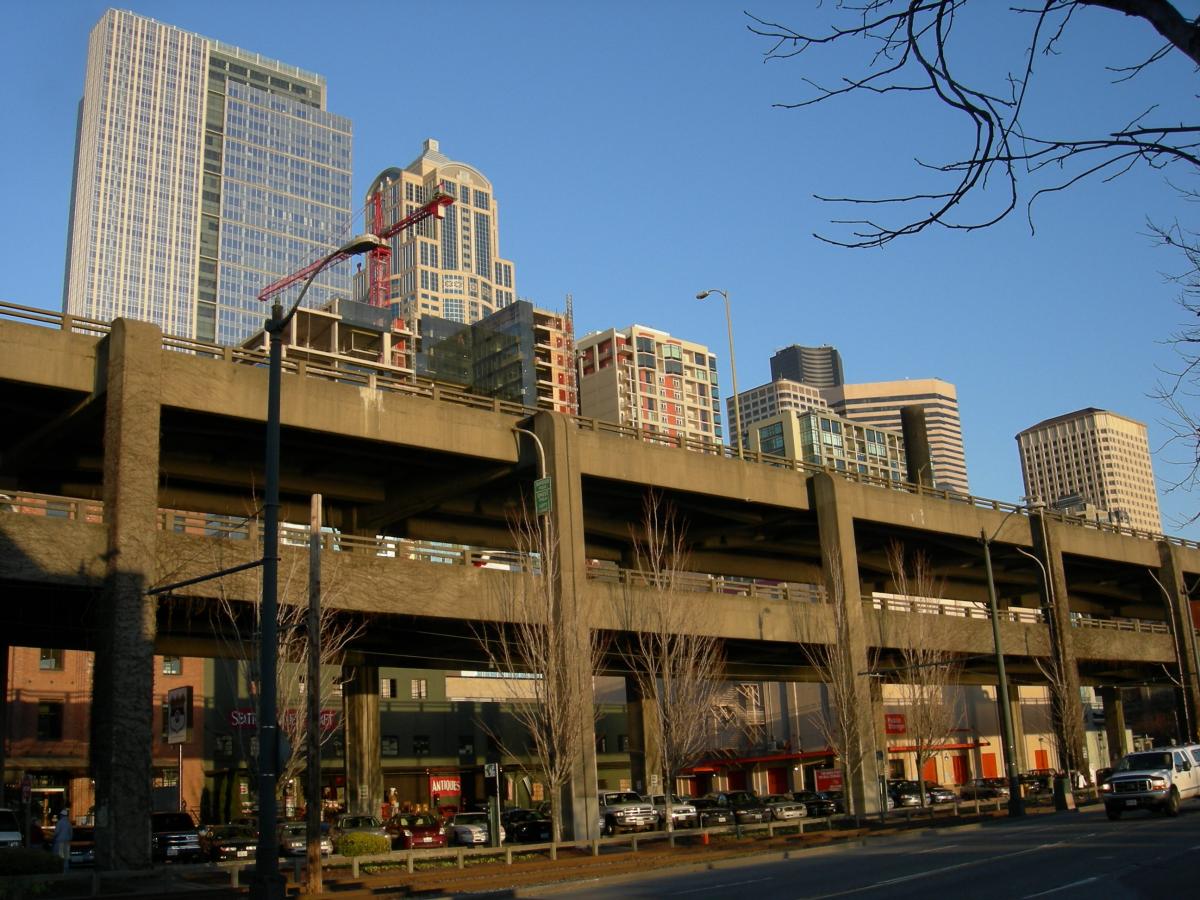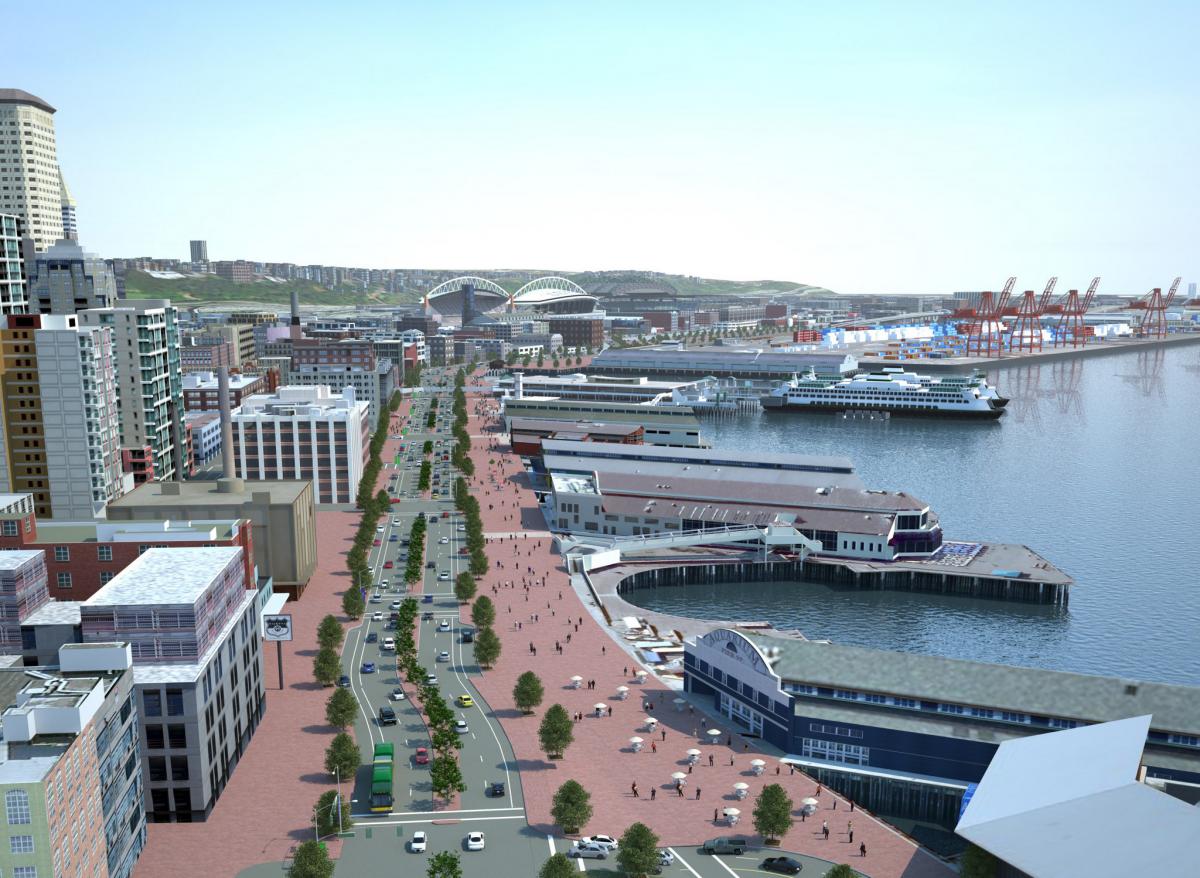- Who We Are
- What We Do
- Our Issues
- Our Projects
- Sprawl Retrofit
- Highways to Boulevards
- CNU/ITE Manual
- Health Districts
- The Project for Code Reform
- Lean Urbanism
- LEED for Neighborhood Development
- Missing Middle Housing
- Small-Scale Developers & Builders
- Emergency Response
- HUD HOPE VI
- Rainwater in Context
- Street Networks
- HUD Finance Reform
- Affordable Neighborhoods
- Autonomous Vehicles
- Legacy Projects
- Build Great Places
- Education & Trainings
- Charter Awards
- Annual Congress
- Athena Medals
- Resources
- Get Involved
- Donate
- Membership
- Public Square
Update: On Friday, January 11, 2019, the Alaskan Way Viaduct was permanently closed to traffic to begin its final demolition. The controversial tunnel that replaces it opened to the public on February 2, 2019. Read more here.
History and Context
Alaskan Way started as a rail yard to accommodate the City's industrial needs along the waterfront of Elliot Bay in the 1880s. As the need for rail decreased with the rise of personal automobiles, the City built the elevated viaduct over the rails in 1953, named it State Route 99 and launched a major north-south thoroughfare in Seattle. Traffic on the Alaskan Way Viaduct was down from its roughly 100,000 daily vehicle peak, though recent rates are difficult to track. Studies conducted in the 1990s revealed the structure was reaching the end of its lifespan. Daily wear and tear, increasing age, salty marine air, and damage by the powerful Nisqually Earthquake in 2001 confirmed the weakening nature of the bridge, requiring costly emergency repairs and calling into question its long-term viability. The City of Seattle and the State of Washington agreed the viaduct must come down.

Proposal
In 2006, the City of Seattle, the State of Washington and the Federal Highway Administration agreed on a cut-and-cover tunnel as the prime replacement option for the viaduct. In the event the tunnel exceeded cost estimates, an alternative to rebuild the elevated viaduct was provided as well, each with price tags of $4 billion or more. Washington State and the City of Seattle grew increasingly embittered with one another disagreeing over which replacement to pursue, calling for a referendum among voters to decide the best option. In March 2007, the people of Seattle strongly voted against both options, welcoming in a surface transit option.
In 2007, after a study by the University of Washington found that damage from continued post-earthquake settling will further harm the structure, the researchers recommended the viaduct be destroyed within 4 years. In January 2008, Governor Christine Gregoire announced that "no action" was not an option and by 2012 the viaduct would come down. At the time of this statement however, no decision was made for a specific replacement.
With the two expensive options off the table, Cary Moon and the People's Waterfront Coalition capitalized on momentum for a surface boulevard and transit alternative. The organization envisioned an open, landscaped boulevard with investment in increasing transit on nearby corridors. This human-scale urban street would have re-opened the waterfront to the community and restore the shoreline, supporting a vibrant urban atmosphere. Further development along the newly opened 22 acres of public land on Seattle's downtown waterfront could have given way to new parks, beaches, and development that could have ultimately save the city years of construction delays and billions of dollars. "If you try to build your way out of congestion," said Moon, "you'll ruin your city or go broke trying."

Current Plans
In 2009, despite best efforts to promote the surface boulevard option and focus investment on serving local mobility, the State of Washington, along with the City of Seattle and King County, decided to replace the viaduct with a deep-bore underground bypass tunnel.
The tunnel project was finally completed three years behind schedule and ran $200 million cost over the initial projected cost, for a total of $3.3 billion. On Friday, January 11, 2019, the City of Seattle began the process of dismantling the elevated Alaskan Way Viaduct, three weeks before the scheduled opening of the tunnel on February 2nd, 2019. During these weeks, the predicted ‘carmageddon’ caused by the highway’s removal failed to manifest, which suggests that the tunnel was an unnecessary expense.
The City of Seattle is now proceeding with the plans for a new civic waterfront, including an urban street with 4 travel lanes, parks, water access, habitat improvements, and better connections to downtown neighborhoods.


















